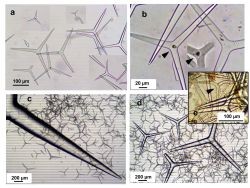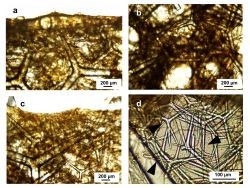blue
white
pink-lilac
lobate
massive
tube
hard
Bahamas
Panama
Leucetta floridana
Description: Single or groups of volcano-shaped tubes, up to about 5 cm high and wide, hanging from cave walls or roofs, or arising from cracks or rubble in more exposed places. Oscules are usually about 0.5-1 cm in diameter, with an elevated collar which thins upward. The atrial cavity is wide and deep. Sometimes the walls of the tubes open, forming irregularly outlined vases-fans. Color light pink or lilac, or light whitish blue. Consistency stiff, like fiberglass; large triactine calcareous spicules stab fingers when handled. Outer (cortical) skeleton conformed by a layer of gigantic triactine spicules tangentially placed at the surface, covered by a layer of smaller tri- and tetractines. Below this cortical layer, the skeleton is a confused mass of spicules. Internal cavities and channels also appear paved by the tangential layer of smaller spicules, in some places with sagittal tri-and tretractines, in addition to the normal ones. We could not see in our tissue sections if the canals were spiked by the apical actines of the tetractines. Spicules are calcareous tri- and tetractines, equiradiate and equiangular. There are two categories of triactines. The smaller (triactines-I), have conical actines, slightly sinuous in outline, sometimes with the basal half cylindrical, and ending in hastate points, 105-260 µm long by 15-30 µm wide (at the base). There are a few smaller triactines, 35-55 x 7.5-10 µm. The larger category of triactines (II) has a wide variety of sizes, from large to gigantic, with conical actines (the first half sometimes cylindrical), 500-3050 µm long by 60-440 µm wide (at the base). Tetractines in the specimens from the Bahamas occur only in the smaller class (I) and have the same overall morphology but are far less numerous and slightly smaller than the triactines-I, the actines measuring 120-190 x 15-21 µm. Basal actine of tetractines I is usually thin (5.5-7.5 µm) and small (up to about 25 µm), pointed, curved or sinuous. There are also smaller tetractines I, with actines 42.5 x 8 µm. Examined specimens from Gulf of Urabá (Colombia), contained a few gigantic Tetractines II, 645-1316 x 96.8-219 µm (Valderrama, 2001; see also Valderrama et al., 2009). Additionally, in some parts of the sponge (which may not be included in the sample processed for spicule analysis but are visible in thick sections of tissue), there are sagittal (one actine long, the other two smaller and symmetrical) tri- and tetractines, with the long actine 125-180 µm by 12-18 µm, and the smaller actines bent in a soaring bird wing fashion, about 90-100 µm long (same maximal width of the long actine). Their apical actine (when tetractine) is also short.
Notes: Valderrama et al. (2009) clarified the taxonomic status of this species with material from the Caribbean and Brazil, rejecting the use of the name Leucetta microraphis (Haeckel, 1872), which corresponds to Indo Pacific populations, and leading to the description of a new species, Leucetta potiguar (Lanna et al., 2009), living sympatrically (usually on exposed substrata) with L. floridana in Brazil. A third, ill known species, L. imberbis (Duch. & Mich., 1864), may be a senior synonym of L. floridana (see WPD), although Lehnert & van Soest (1998) described it as different and co-existing with L. floridana in Jamaica.
Author Reference: (Haeckel, 1872)
Link: World Porifera Database


